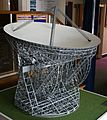Jodrell Bank Observatory facts for kids
The Jodrell Bank Observatory is a famous place in Cheshire, United Kingdom. It is home to giant radio telescopes that listen to radio waves coming from outer space. These telescopes help scientists learn amazing things about planets, stars, and the universe.
Jodrell Bank is a very important place for science. In 2019, it became a UNESCO World Heritage Site. This means it is recognized globally for its special history and what it has taught us about space.
| Top - 0-9 A B C D E F G H I J K L M N O P Q R S T U V W X Y Z |
What is Jodrell Bank Observatory?
The Jodrell Bank Observatory is like a giant ear for listening to the universe. Instead of seeing light, its telescopes pick up radio waves. These waves are invisible to our eyes but carry lots of information from distant objects in space.
Scientists use Jodrell Bank to study many different things. They look at meteoroids (small rocks in space), quasars (very bright objects powered by black holes), pulsars (spinning stars that send out radio pulses), and even how gravity can bend light, called gravitational lensing. The observatory has also been very important for tracking space probes as they travel through our Solar System.
How it Started
The idea for Jodrell Bank came from a scientist named Bernard Lovell. He was a professor of Astronomy at Manchester University. During World War II, Lovell worked with radar, which uses radio waves to detect objects. After the war, he wanted to use similar technology to study cosmic rays from space.
So, in 1945, the observatory was set up. It started small, but soon grew to become one of the most important radio observatories in the world.
The Amazing Telescopes
The main telescope at Jodrell Bank is called the Lovell Telescope. It is named after Bernard Lovell. This telescope is enormous! It is 250 ft (76 m) wide, which is about the length of a football field. It is the third-largest steerable radio telescope in the world. "Steerable" means it can move and point to different parts of the sky.
There are three other active telescopes at the observatory:
- The Mark II telescope.
- A 42 ft (13 m) wide radio telescope.
- A 7 m wide radio telescope.
These telescopes work together to gather even more information from space.
MERLIN: Working Together
Jodrell Bank is also the home base for something called the Multi-Element Radio Linked Interferometer Network (MERLIN). This is a special network of radio telescopes. What does that mean? It means several radio telescopes, located in different places, can work together as if they were one giant telescope.
By combining the signals from these telescopes, scientists can get much clearer and more detailed images of space. It's like having super-powered vision for radio waves. The University of Manchester runs this important "National Facility."
Big Discoveries from Jodrell Bank
Jodrell Bank has made some incredible discoveries over the years. One of its first big achievements was finding radio noise coming from the Great Nebula in Andromeda. This was the first time anyone had clearly detected a radio source from outside our own galaxy.
The observatory also discovered radio waves from the remains of Tycho's Supernova. A supernova is a huge explosion of a star. At the time, regular light telescopes had not yet found these remains. Jodrell Bank's radio telescopes were able to "see" what optical telescopes could not.
Images for kids
See also
 In Spanish: Observatorio Jodrell Bank para niños
In Spanish: Observatorio Jodrell Bank para niños










